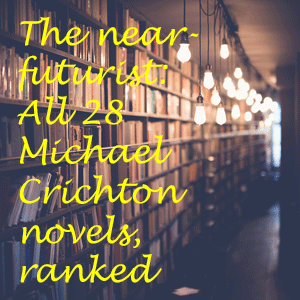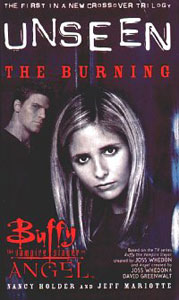“Unseen I: The Burning” (May 2001), the first of a “Buffy”/“Angel” crossover trilogy, is one of the more unusual Buffyverse books so far. It’s notably decompressed, features many different storylines, and –most strikingly – digs into themes that don’t seem to be in the wheelhouse of this saga. For instance, Buffy is going after Los Angeles street gangs and Angel is trying to help a man who has been framed by corrupt L.A. cops.
Set after Season 4 of “Buffy” and Season 1 of “Angel,” “The Burning” opens with authors Nancy Holder and Jeff Mariotte noting that it’s a particularly hot summer, something that was emphasized in the comic arc “Out of the Woodwork” (“BTVS Classic” Issues 31-34), which is also set during the post-Season 4 summer and was published at the same time.
The title “The Burning” also refers to a Latino youth named Nicky setting aflame Sunnydale’s oil fields in order to get noticed by the L.A. branch of his gang. Buffy and Willow are drawn into this case by Nicky’s sister, UC-Sunnydale student Salma, who asks for their help.
Meanwhile, Angel helps Rojelio Flores, who has been framed by cops who need to cover up their own murder in a conflict with a Russian L.A. gang. This case comes from a vision from Cordelia courtesy of the Powers That Be. (This is the first “Angel” novel to take place after Doyle’s death; the books skip over the entire second half of Season 1.)
It turns out that there are supernatural aspects to both cases. Nicky is impervious to the flames, thanks to a spell he performs. And Flores’ telekinetic powers manifest from the stress of his situation. It’s interesting, though, that the supernatural aspects are coincidental; even if these were “normal” cases, Buffy and Angel still would try to help these people.
Is that a feature or a bug of “The Burning?” At first it struck me as odd, but eventually I grew to enjoy the idea of our heroes in totally new situations. The oddity of Buffy’s storyline is particularly striking when she goes up against machine-gun wielding gangbangers. Unlike the bulk of the TV series, Holder and Mariotte don’t conveniently dodge the question of what would happen if a Slayer went up against villains who wield guns.
The “Unseen” part of the title refers to a pretty cool villain: A monster (or group of monsters) that manifest amid unnatural darkness and can’t be seen by our heroes. The authors evoke something like Stephen King’s “The Mist” when Buffy wades out into the black to fight these invisible creatures.
Everyone gets a little something to do here, except Xander and Anya, who are relegated to background quippers. It’s a pleasant surprise to find Riley and Tara working together, as they have the common element of feeling a bit outside the Scooby core. I like the idea of Spike – who has the chip in his head at this point – being rejected by vampire women because he can’t kill humans.

And it’s nice to see Cordelia and Wesley working to solve a problem without Angel. They attempt to convince a group of homeless girls that it’s a bad idea to be turned into vampires — a decompressed reprise of “Lie to Me” (“Buffy” 2.7).
The book gets an extra half-banana for being smart about continuity. Gunn and his vampire-hunting friends help Cordy and Wesley against the girls’ would-be vampire savior Kostov, but they disappear from the scene before formal introductions can be made. That allows “Unseen” to fit on the timeline in the period after Gunn is introduced in late Season 1 but before he formally meets Cordy and Wes in early Season 2.
“The Burning” is definitely, ahem, slow-burning. Still, it’s a page-turner because Holder and Mariotte know how to keep us interested. For example, Kostov is mentioned long before we meet him, which piques our curiosity. I feel like the authors are consciously trying to do something different by putting our heroes in situations we never see in their TV series. By the end, I had warmed up to the idea.
Click here for an index of all of John’s “Buffy” and “Angel” reviews.

